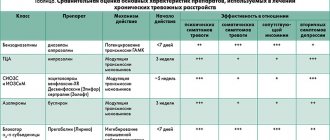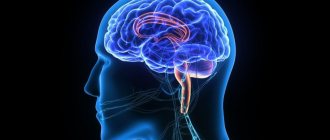Senile dementia is a psychoneurological pathology caused by organic disorders in the functioning of the brain and blood vessels. Cognitive impairment in this disease always comes to the fore.
First of all, a person ceases to be aware of his actions, is poorly oriented in familiar terrain, is unable to use complex equipment and poses a danger to himself.
The first signs and symptoms: loss of memory for current events, while maintaining general knowledge and skills, inability to competently use household appliances and complex devices.
Causes
For a long time, the main cause of vascular dementia was considered to be acute cerebrovascular accidents (hereinafter referred to as ACVA, which means, first of all, stroke). A stroke develops as a result of blockage of an artery by an embolus or thrombus (ischemic stroke) or when an artery ruptures and hemorrhages in the brain (hemorrhagic stroke). In this case, due to lack of nutrition, neurons die.
After a stroke, the likelihood of developing vascular dementia increases significantly. Within 1 year after a stroke, vascular dementia develops in a quarter of patients. The nature of the manifestation of symptoms depends on the area of the brain in which the disorder occurred. The size of the lesion also plays a role. Vascular dementia usually develops when more than 50 ml of brain volume is affected.
However, if circulatory disorders occur in areas important for cognitive functions (visual thalamus, hippocampal region, frontal prefrontal cortex, etc.), then a smaller area of neuronal death can lead to the development of vascular dementia. If other areas are affected, motor disorders and other post-stroke manifestations may occur.
It has now been established that vascular dementia is not always associated with acute disorders. It can occur due to a chronic dyscirculatory process - blockage of small vessels that occurs unnoticed by the patient (the so-called subcortical vascular dementia). It has also become possible to detect these disorders thanks to the spread of digital technology and the spread of neuroimaging methods in medicine.
Neuroimaging (functional MRI, PET, etc.) allows one to observe “silent” areas of vascular lesions in the brain that previously went unnoticed as not leading to an acute lesion (stroke). The development of vascular dementia is possible with a decrease in blood perfusion in the brain.
This occurs against the background of acute or decompensated chronic heart failure, a decrease in circulating blood volume, and a sharp decrease in blood pressure. All these phenomena lead to insufficient blood supply in the peripheral microcirculatory zones of all vascular beds and neuronal death. Based on this, the occurrence of vascular dementia is influenced by two components: stroke and a chronic discirculatory process. When these disorders occur simultaneously, they reinforce each other, leading to more pronounced symptoms.
Let's consider the mechanism of development of vascular dementia.
When the vascular link in various parts of the brain is damaged, neurons do not receive the required amount of oxygen and nutrients, which leads to the death of these cells. Initially, the brain compensates for the violations - they do not appear externally. Over time, the potential is depleted, negative changes begin to affect the state of memory, speech, concentration and speed of thinking. As a result of these cognitive disorders, a person’s behavior changes, and his independence decreases.
All types of vascular dementia account for up to 15% of all cases of dementia in the elderly. There are also often cases of mixed dementia, which combine vascular dementia with Alzheimer's disease. It is believed that as a person ages, the risk of vascular dementia decreases, while the risk of developing Alzheimer's disease increases.
In this regard, the vascular factor is recognized as especially dangerous in the Russian Federation, where life expectancy is still not very high and part of the population simply does not live to the age of onset of another type of dementia. Vascular dementia is also widespread compared to Alzheimer's disease in some Asian countries (Japan, China), and a number of Scandinavian countries (Finland, Sweden).
Risk factors for vascular dementia are:
- high or low blood pressure,
- cerebral atherosclerosis,
- hyperlipidemia,
- cardiac ischemia,
- diabetes,
- arrhythmias,
- hyperhomocysteinemia (now this factor is considered doubtful),
- pathology of heart valves,
- vasculitis.
Smoking, poor diet and a sedentary lifestyle contribute to the risk of developing vascular dementia.
Types of disease
Each type of senile dementia has its own code in ICD-10.
F00*
For Alzheimer's disease . The disease has neuropathological features and progresses over the years. The onset of the disease is 50–65 years .
Neurotic character traits become aggravated, anxiety and fear for oneself and loved ones come to the fore, poor memory aggravates the anxious state.
It is difficult for a person to express his thoughts. Over time, the help of a social worker is required. The pathological condition is dealt with by a neurologist and a psychiatrist.
Basic drugs with cholinesterase inhibitors that correct the patient’s well-being:
- Donepezil;
- Memantine;
- Nootropics.
Treatment with folk remedies:
- withania root;
- black tea with sugar;
- ginseng.
F01
Vascular dementia . The consequence of hypertension is damage to the blood vessels of the brain. Makes itself felt in old age.
Brain neurons die from insufficient blood supply, the cause is atherosclerosis and coronary heart disease. The attending physician is a neurologist.
Drugs
prescribed :
- Nootropics.
- Memantinol.
As additional treatment methods, you can resort to traditional medicine :
- lemongrass is steamed;
- Eleutherococcus is taken in drops.
Concomitant diseases : arterial hypertension, concussions, stroke.
F02.0
Pick's disease . A type of senile dementia with lesions in areas of the brain located in the frontal lobes.
It manifests itself in the same way: antisocial behavior, disinhibition of instincts, loss of cognitive abilities.
Treatment: neuroleptics and anticholinesterase agents.
F02.1*
For Creutzfeldt-Jakob disease . Genetic and viral pathology causes mutation of a healthy protein.
The pathogenic prion protein accumulates in the body, destroying healthy brain cells (there are no cells suitable for the development of the virus in other tissues).
Cases of infection have been reported from eating beef.
Signs of pathology remain unnoticed until old age . It is after 55 years that the degenerative properties of tissues allow the protein to develop in the human body.
F02.2*
For Huntington's disease . A hereditary disease caused by degeneration of gamma-aminobutyric acid.
A hallmark of this type of dementia is the presence of hallucinations and antisocial behavior. The disease is transmitted by a dominant type.
This type of dementia is difficult to distinguish from other types; the only symptom, a marker of the disease, is hyperkinesia.
F02.3*
For Parkinson's disease . Parkinson's disease is a debilitating neurological condition that causes dementia.
A lack of dopamine in the brain and insufficient transmission of dopamine to nerve endings make it difficult to move smoothly and make speech poor.
Protein deposits in the brain replace healthy tissue, blocking dopamine receptors, resulting in akathisia and tremors.
F02.4*
For an illness caused by the human immunodeficiency virus [HIV] (B22.0+) . HIV dementia is a complex of symptoms caused by microorganisms that do not develop if a strong immune system is present.
The severity of this type of dementia in older people is practically not observed - this is a special form of HIV infection.
F03
Unspecified (NOS “not otherwise specified”) . Senile dementia with no symptoms.
The illness is on the verge of psychology/psychiatry and is often hysterical in nature. Common name: senile sclerosis.
Senile and presenile dementia
Presenile dementia occurs at early retirement age. Alzheimer's disease is an indicative type of presenile dementia.
A person ceases to understand the speech of others, and difficulty reading newspapers arises. The patient lets himself go.
Habits from a past life are forgotten, hygiene and comfort fade into the background.
Life activity decreases, by the age of 60–65 a person stops moving and slowly dies.
Alzheimer's type
Classic dementia of the Alzheimer's type is quite severe. It is diagnosed after 65 years , most likely, this is the middle - late stage of the disease.
The patient cannot distinguish complex phrases spoken to him at moderate volume. The sounds of speech perceived from the outside turn into cacophony. Rigidity of character is due to the restructuring of the brain to a simplified mode.
There is no place for hobbies and friends in a person’s life; all the time he is focused on himself and his experiences. Amnestic dementia syndrome, as a marker of the disease, occurs at a late stage of the disease.
Characterized by the inability to remember any dates or numbers.
At this stage the person becomes incapacitated . Mnestic-intellectual functions disintegrate, a person completely loses the concept of time and space. The rhythm of wakefulness is disturbed, night sleep is superficial.
The prognosis of the disease is disappointing, leading to complete maladaptation and disability . The drugs relieve only neurological symptoms, such as high blood pressure and tremors.
Symptoms
As a rule, “vascular dementia” is diagnosed if cognitive impairment was preceded by a stroke. Quite often, accompanying signs are symptoms of focal brain damage, for example, manifestations of hemiparesis (weakness of the muscles of one side, anisoreflexia, pathological foot signs, etc.). A characteristic symptom is a walking disorder - a slow, shuffling gait and instability (which patients themselves often call dizziness).
As mentioned above, the cause of vascular dementia lies in circulatory disorders in the brain. The potential for disturbances to occur exists in different areas of the brain. Therefore, the external manifestations of vascular type dementia differ significantly in each case. Let's list the most typical ones.
Dementia caused by damage to the midbrain is manifested by mesencephalothalamic syndrome. The first manifestations are confusion and hallucinations. A person becomes apathetic, withdraws into himself, does not care about his appearance, and neglects personal hygiene. His psychophysiological state is usually characterized by increased drowsiness. In some cases there are speech disorders.
In dementia caused by damage to the hippocampus, first of all, there is an impairment in the ability of memory to retain information about current events (long-term memory can be retained).
As a result of a stroke, apathetic-abulsic syndrome is observed in the prefrontal regions of the frontal lobes. The patient behaves inappropriately, there is no criticism of the condition. Inadequacy consists in repeated repetition of one’s own words and actions, or the words and actions of others.
Subcortical lesions lead to disruption, first of all, of daily activities: it is difficult for the patient to concentrate on one subject and maintain one type of activity; problems arise with making plans. There is also a violation of the skills of information analysis (separation of the main from the secondary).
A stable sign of vascular dementia is impaired urination; it is observed in almost all persons suffering from dementia.
Symptoms of vascular dementia are also noticeable in the psycho-emotional sphere. There is a general decrease in mood and self-esteem, emotional instability, depression appear, and self-confidence is lost.
Vascular dementia
A distinctive feature of vascular dementia is a combination of cognitive and neurological disorders. With a stroke, cognitive impairment usually occurs within a month (less often, three months) from the moment of the vascular accident. With multiple small strokes, this period can increase to six months. The nature and severity of pathological changes are determined by the area and size of the lesion. Typical features of vascular dementia are slowing of mental processes, decreased mental flexibility and a narrowing of interests.
Memory impairments occur already in the initial stages of the disease and are milder than in Alzheimer's disease. The patient forgets some episodes from the past. The ability to assimilate new material decreases. A patient with vascular dementia remembers words and movements worse, while passive recognition is usually preserved; the main difficulties arise when trying to independently reproduce a new word or learn new motor skills.
Speech, reading, counting and writing disorders of varying severity may be observed. In the initial stages of vascular dementia, the patient forgets individual words. Later, forgetting words becomes more frequent; the patient does not always understand the meaning of speech addressed to him, especially when listening to monologues and extended sentences. In the absence of motor aphasia, patients with vascular dementia can be talkative, but since they themselves do not understand the meaning of their own speech, substitutions and rearrangements of letters, syllables and entire words appear in their speech.
Cognitive disorders gradually progress, and the ability for self-care and normal functioning in society decreases. Thinking slows down and becomes more rigid. Patients suffering from vascular dementia experience difficulty maintaining and purposefully switching attention. They have poor spatial orientation (especially in unfamiliar surroundings) and get lost when trying to make a purchase or complete documents. As vascular dementia progresses, patients cannot dress themselves, prepare food, etc.
Many patients experience emotional incontinence, which may manifest as violent crying or weakness. Some patients become angry, irritable, and distrustful. The development of depression and psychosis is possible. A characteristic feature of vascular dementia is the wave-like course of the disease. All of the above symptoms either progress, or stabilize, and sometimes even undergo some reverse development. The state of the psyche and intellect often depends on the degree of cerebral circulation impairment at a given time.
Possible neurological disorders in vascular dementia include cerebellar, pseudobulbar, subcortical and pyramidal syndromes, gait disturbances and paresis (usually mild). There is often a violation of control over the activity of the pelvic organs. Some patients with vascular dementia experience paroxysmal conditions: epileptoid seizures, falls. The clinical picture is very diverse; in some patients, neurological symptoms can be pronounced, in others they can be subtle, almost imperceptible.
Diagnostics
Dementia of the vascular type is diagnosed in the presence of clinical data, characteristic anamnestic or neuroimaging signs of cerebrovascular disease: previous stroke or cases of subclinical local cerebral ischemia.
It is also important to have a cause-and-effect relationship and a relationship in time between brain damage of vascular etiology and the development of cognitive impairment. The very presence of dyscirculatory disorders according to neuroimaging, as well as the presence of neurological disorders - hemiparesis, speech and swallowing disorders, walking and urination disorders, are mandatory.
It is necessary to differentiate between Alzheimer's disease and vascular dementia.
Once the syndrome of dementia is identified, it should be syndromicly distinguished from depression, moderate or even mild cognitive impairment and delirium. To diagnose depression, various questionnaires and tests should be used (clock drawing test, HADS anxiety and depression scale, Montreal Mental Status Scale, MMSE test, etc.).
The distinction between vascular dementia and dementia due to Alzheimer's disease is often difficult. If in Alzheimer's disease the deterioration can occur slowly and constantly, then in the case of vascular dementia the deterioration occurs suddenly (for example, after stroke) and proceeds in stages.
When the vascular component predominates, the following signs are common: focal neurological symptoms (rigidity, hemiparesis, bradykinesia, bulbar disorders), neuropsychological disorders depending on the location of the cerebral infarction (aphasia, lack of sensory sensitivity, apraxia), gait disturbances (with Parkinson-like or ataxic movements), urinary disorders with urinary incontinence and urgency.
In addition to a thorough neurological examination and targeted laboratory tests, MRI or MSCT is necessary to identify infarcts and white matter lesions.
It must be remembered that quite often the same patient exhibits both signs of vascular dyscirculation and symptoms of Alzheimer's disease. Modern research indicates that the chronic dyscirculatory process is a risk factor for the development of Alzheimer's disease and plays a pathogenetic role in the neurodegenerative process, based on this, the vast majority of cases of dementia are mixed in their pathogenesis - vascular-degenerative.
Dementia: code in ICD-10
Dementia is any acquired dementia. It may be based on many organic causes, depending on the age and under what conditions it appeared. There are many forms, but the most common include:
- Vascular - with it, problems with mental activity arise due to circulatory disorders.
- Senile – also called senile, as it appears due to age-related changes in the brain.
- Mixed – which is based on both vascular and age-related disorders.
- Unspecified genesis - this form is spoken of if the objective reasons for the development of the disease could not be determined.
- Dementia associated with Alzheimer's disease.
Each of these forms is presented separately in the structure of ICD 10 and at the same time they are all combined under a common heading, since they have similar symptoms, origin, and often treatment. The general ICD 10 code for dementia in adults is presented in block F00-F03. It means that the syndrome of any of the presented forms is among the organic mental disorders (class F).
The main reason for combining diseases into this block is the fact that at the heart of all of them there is a clearly visible etiological factor. This means that the root cause of dementia is always brain disease, injury or stroke.
Important! If a mental disorder occurs due to other problems, it cannot be called dementia, even if it is similar symptomatically; accordingly, it will belong to another category of ICD-10.
Signs of the syndrome develop gradually; any form of the disorder is considered progressive. But his signs are always the same and clearly defined in the classification, be it dementia of mixed genesis according to ICD 10 or typical senile insanity. Here are the main ones:
- Higher cognitive functions always suffer, namely memory, thinking, attention, orientation, speech.
- Control over the emotional sphere, motivation, and one’s own behavior deteriorates.
- Motor functions gradually deteriorate.
To determine which form is typical for each specific patient, additional codes are used.
Treatment
Treatment of vascular dementia should be aimed at correcting the pathological factors leading to this condition, as well as directly correcting cognitive functions. It makes no sense to describe all kinds of treatment regimens and give the names of specific drugs with their course and single doses in this article, because each specific case requires an individual approach.
The general principles of therapy for vascular dementia should be the correction of hypertension and cholesterol levels (however, you should not reduce cholesterol levels below 3.5-4 mmol/l due to the risk of a combination of Alzheimer's disease and vascular dementia, and Alzheimer's disease reacts negatively to low cholesterol levels , although, unfortunately, it is not entirely clear why), as well as the use of antiplatelet or anticoagulant therapy.
It is important to carry out a course of treatment with antioxidant (Mexidol, Cytoflavin, etc.), neuroprotective (Actovegin, Ceraxon, Cortexin, etc.), vasoactive (Sermion, Cavinton, etc.) drugs, with individual selection based on availability contraindications in the patient and the clinical picture as a whole, as well as (the author’s opinion), anti-dementia drugs should be used, and the drug of choice should be memantines (Akatinol, Marux, etc.).
An equally important point is non-drug therapy, namely proper patient care and psychological comfort. After all, if you are surrounded by close people, and they treat you with a positive attitude, life becomes a little better.
Classification of dementia codes in ICD 10
As indicated, any dementia syndrome is included in class F and is additionally coded with a digital designation from 00 to 03. Their systematization and distinctive features are presented in more detail in the table.
Basic codes for dementia in ICD-10
| Name of the disease | Code in the ICD 10 classification | Distinctive features |
| Dementia associated with Alzheimer's disease | F00 | The disease is based on a severe degenerative disorder with specific neurochemical manifestations. |
| Vascular dementia | F01 | Appears due to disruption of the blood vessels in the brain, which in turn cause a heart attack. |
| Dementia developing against the background of other diseases | F02 | The basis of the problem is diseases originally classified in other ICD categories. Accordingly, dementia always appears secondarily. |
| Dementia of unspecified origin | F03 | The causes of the disease are not entirely clear. This ICD 10 group includes many forms of dementia. |
Important! Regardless of which form of the disorder is diagnosed, they are united by two features: the disease always progresses slowly and cannot be cured.
Some forms of dementia in the ICD-10 classification have additional coding because they have exceptional features during the course of the disease, its symptoms or other aspects.
Vascular dementia in ICD-10
Vascular dementia code according to ICD 10 is F01, but this group includes not one, but several separate forms. They are all connected by a common reason - they develop against the background of vascular dysfunction. The time of manifestation of the disease also usually coincides - it occurs at a late age - after 70 years.
Moreover, there are people who are initially predisposed to the development of this form of pathology (diabetics, people suffering from arterial hypertension, smokers). Additional codes are applied due to existing differences:
- F0 - used to designate acute onset dementia as a result of multiple strokes, hemorrhage or cerebral infarction.
- F1 – denotes dementia caused by constantly recurring heart attacks. Most often, this disease affects the cortical structures.
- F2 – intended for cases of dementia originating in subcortical structures.
- F3 – used to designate mixed dementia, developing in both cortical and subcortical structures.
- F8 and F01.9 are vascular dementias, which are based on other problems, often not specified.
The type of vascular dementia and the ICD code are determined as a result of examinations, although they do not have fundamentally different treatment.
Dementia in other diseases
Coding F02 in ICD 10 refers to dementia, the cause of which was various neurological diseases not associated with Alzheimer's or vascular disorders. Their peculiarity is that the age range of manifestations of dementia is much wider, moreover, they are mainly diagnosed at a fairly young age. The group includes:
- F0 – appears as a secondary problem of Pick's disease.
- F1 – dementia based on Creutzveld-Jakob disease. One of the fastest growing forms of the disorder, in which death occurs within a couple of years.
- F2 – dementia in Huntington's disease. It is characterized by extensive degeneration of the brain, and the disease is considered one of the youngest, since it appears already in the third decade.
- F3 – dementia based on Parkinson's disease. It is distinguished by the predominance of motor disorders.
- F4 – is caused by HIV, and therefore always has a complex clinical picture.
- F8 – dementia that begins due to any other diagnosed diseases, if their relationship is proven.
At the same time, the ICD 10 code for dementia in Alzheimer's disease differs from all those listed. It stands out as a separate group, since the disease is most common compared to other forms of disorders.
Alzheimer's dementia
The disorder associated with Alzheimer's disease is also divided into several separate subtypes in ICD 10. They are mainly associated with the period of development of the disease, but there are other nuances that stand out separately:
- F0 – dementia in early Alzheimer's disease. It appears before the age of 65 and develops quite progressively.
- F1 – late-onset Alzheimer's dementia. Often the ICD 10 code for senile dementia coincides with this type.
- F2 – atypical dementia or dementia of mixed type, which arose against the background of Alzheimer's disease.
- F9 – unspecified Alzheimer's dementia.
Strictly speaking, in the realities of Russian medicine, additional clarification of the diagnosis coding for confirmed Alzheimer’s disease is rarely assigned. They do not differ in treatment methods. Is that the speed of development is faster in some places, slower in others.
Dementia unspecified according to ICD 10 is allocated in a separate section. This happens if the patient has not undergone enough research to establish the exact basis of the disease or they have not shown a clear clinical picture. The mixed dementia code according to ICD 10, as well as the senile dementia code according to ICD 10, do not have their own code. In the classification, such disorders join other groups, often with dementia, the exact causes of which are not established.
The wide variety of types and forms of this mental disorder has not led to the creation of unique treatment methods and, by and large, the list of drugs used is the same in all cases. The fact is that in this case, individual elimination of symptoms is much more effective; medications are selected taking them into account.
But this does not mean that you can resort to self-medication. The doctor leading the patient plays a major role in obtaining a positive result. Therefore, whatever the basis of the pathological process and at whatever stage it is detected, it is necessary to immediately contact a specialist who can select medications.
Forecast
At the present stage of development of medicine, the prognosis for recovery for any type of dementia is unfavorable. Dementia is considered to be an irreversible condition. There is also an unfavorable prognosis for work ability (a patient with dementia is a priori disabled), a relatively unfavorable prognosis for life, but vascular dementia itself is not the cause of the patient’s death.
Death often occurs due to cancer, acute vascular accident, and infectious lesions (especially important among which are diseases of the genitourinary tract due to poor hygiene in patients with dementia).










